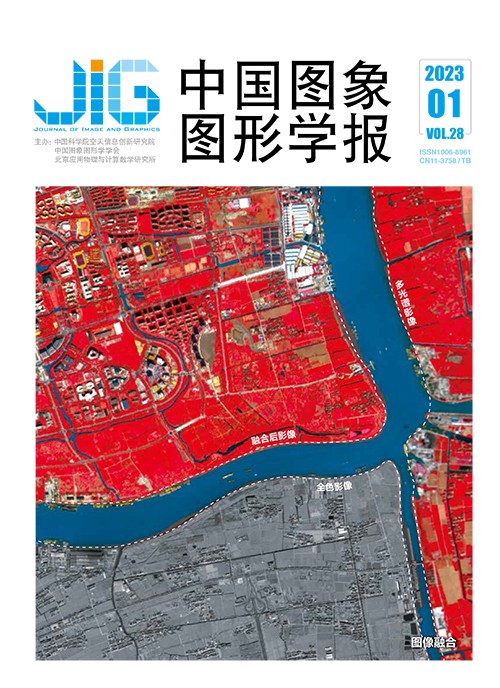
可见光与红外图像融合质量评价指标分析
摘 要
目的 客观评价作为图像融合的重要研究领域,是评价融合算法性能的有力工具。目前,已有几十种不同类型的评价指标,但各应用领域包括可见光与红外图像融合,仍缺少统一的选择依据。为了方便比较不同融合算法性能,提出一种客观评价指标的通用分析方法并应用于可见光与红外图像融合。方法 将可见光与红外图像基准数据集中的客观评价指标分为两类,分别是基于融合图像的评价指标与基于源图像和融合图像的评价指标。采用Kendall相关系数分析融合指标间的相关性,聚类得到指标分组;采用Borda计数排序法统计算法的综合排序,分析单一指标排序和综合排序的相关性,得到一致性较高的指标集合;采用离散系数分析指标均值随不同算法的波动程度,选择充分体现不同算法间差异的指标;综合相关性分析、一致性分析及离散系数分析,总结具有代表性的建议指标集合。结果 在13对彩色可见光与红外和8对灰度可见光与红外两组图像源中,分别统计分析不同图像融合算法的客观评价数据,得到可见光与红外图像融合的建议指标集(标准差、边缘保持度),作为融合算法性能评估的重要参考。相较于现有方法,实验覆盖20种融合算法和13种客观评价指标,并且不依赖主观评价结果。结论 针对可见光与红外图像融合,提出了一种基于统计分析的客观评价指标分析方法,该方法可以推广至更多的图像融合应用,指导选择具有代表性的客观评价指标。
关键词
Analysis of quality objective assessment metrics for visible and infrared image fusion
Sun Bin1,2, Gao Yunxiang1,2, Zhuge Wuwei1,2, Wang Zixuan1,2(1. School of Aeronautics and Astronautics, University of Electronic Science and Technology of China, Chengdu 611731, China;2. Abstract
Objective As a research branch in the field of image fusion, objective assessment metrics can overcome these shortcomings of subjective evaluation methods that are easily affected by human psychological interference, surrounding environment, and visual characteristics. It can be utilized to evaluate algorithms and design parameters. Our algorithms advantages proposed can be demonstrated via objective assessment metrics. However, there is still a lack of benchmarks and metrics in various application fields like visible and infrared image fusion. A couple of objective assessment metrics can be selected based on prior experience. To facilitate the comparative analysis for different fusion algorithms, our research is focused on a general option method for objective assessment metrics and a set of recommended metrics for the fusion of visible and infrared images. Method A new selecting method for objective assessment metrics is built. Our method consists of three parts: 1) correlation analysis, 2) consistency analysis and 3) discrete analysis. The Kendall correlation coefficient is utilized to perform correlation analysis for all objective assessment metrics. All the objective assessment metrics are clustered according to the value of the correlation coefficient: if the Kendall value of two metrics is higher than the threshold, the two metrics will be put into the same group. The Borda voting method is used in the consistency analysis. There is a ranking for all algorithms in terms of each metric value. An overall ranking is also generated by Borda voting method based on each single ranking of different metrics. The correlation coefficient is used to analyze the consistency between each single ranking and the overall ranking. The objective assessment metric has higher consistency if its correlation coefficient value is higher. Such experiments showed that the metric value will be fluctuated if the fusion quality is changed. A good metric should reflect the fusion quality of different algorithms clearly, so the metric value will cause a large fluctuation in terms of different fusion quality. The different fusion quality we illustrated is originated from multiple algorithms. The coefficient of variation is used to interpret the fluctuation because different objective assessment metrics match different measurement scales. The coefficient of variation reflects overall fluctuations under the influence of the measurement scale. Therefore, the final selected objective assessment metrics set has the following three characteristics: 1) high consistency, 2) high coefficient of variation and 3)non-same group. Result The experiments are conducted on the visible and infrared fusion benchmark (VIFB) dataset. The experiments are segmented into two groups in terms of the visible images in the dataset in related to grayscale images and RGB color images. The recommended objective assessment metric set is under the fusion of visible and infrared image, color visible and infrared image fusion: {standard deviation(SD), QAB/F} or {SD, QCB}; gray visible and infrared image fusion: {SD, QAB/F} or {QCB}. Under the fusion of color visible and infrared image, both of QAB/F and QCB had good consistency and coefficient of variation within the same group. It did not make much difference to choose each of them. Combining the results of the two sets of experiments, {SD, QAB/F} is applied to visible and infrared image fusion. SD is focused on evaluating the contrast information of the fused image, which can intuitively reflect the quality of the fusion of visible and infrared images. QAB/F is focused on evaluating the edge details. The comparative analysis shows that the algorithms filtered by two objective assessment metrics are similar to the individual subjective evaluation results. The objective assessment metric set selected by our method can be used as a basis for evaluating the performances of visible and infrared fusion algorithms. Compared to the existing methods, this method covers more fusion algorithms and objective assessment metrics without subjective evaluation results. Conclusion A general selecting method for objective assessment metrics is proposed. The method is not only matched for the fusion of visible and infrared images, but also applies to image fusion in other scenes. Our quick-response method can screen out the most representative objective assessment metric in a scene. Based on the benchmark of visible and infrared image fusion, the recommended representative objective assessment metrics of visible and infrared image fusion are SD and QAB/F.
Keywords
image fusion objective assessment metrics correlation analysis consistency analysis coefficient of variation
|



 中国图象图形学报 │ 京ICP备05080539号-4 │ 本系统由
中国图象图形学报 │ 京ICP备05080539号-4 │ 本系统由